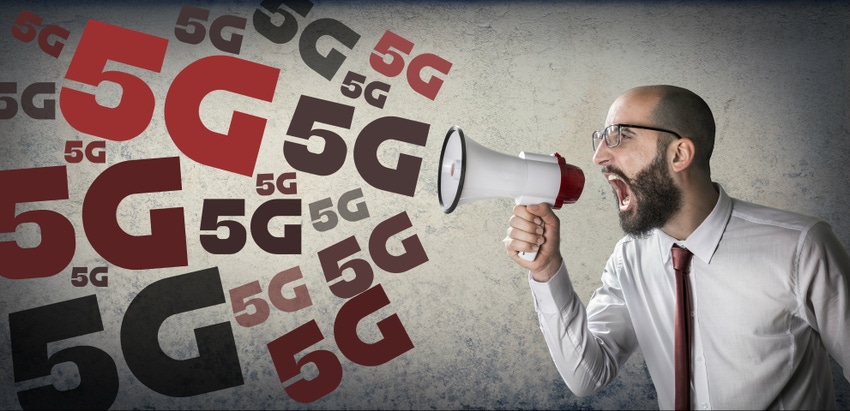The mobile industry needs 5G, or congestion and a declining mobile experience will make it hard for operators to maintain existing revenue levels, let alone increase them.
February 22, 2019

Telecoms.com periodically invites third parties to share their views on the industry’s most pressing issues. In this piece Ian Fogg, VP of Analysis at OpenSignal, urges the telecoms industry to accentuate the positive when it comes to 5G.
As 5G arrives in 2019, the early hype is beginning to be replaced by criticism that early 5G deployments will not be so different to 4G. The implication is clear: 5G isn’t a big deal. The problem with this analysis is that it confuses potential initial 5G teething issues with the real importance of 5G for the future.
4G networks are becoming overloaded. Today, we can see enormous mobile network experience differences by comparing otherwise similar cities. The success of the smartphone boom and cheaper and cheaper data tariffs are continuing to drive up mobile data usage. Consumers need 5G to relieve pressure on existing networks, otherwise speeds and other mobile network experience factors will worsen. The mobile industry needs 5G, or congestion and a declining mobile experience will make it hard for operators to maintain existing revenue levels, let alone increase them. Mobile network vendors need 5G to succeed to support capital expenditure by operators.
We at OpenSignal can see these real-world mobile broadband challenges across the world. We see the fastest speeds and best latencies in cities where operators have deployed solid 4G networks and priced data at a sustainable price (not as a bargain).
For example, there are clear-cut differences today in 4G experience between otherwise similar cities, likely because of the degree of smartphone usage:
In South-East Asia, the 4G Download for smartphone users in Singapore is far faster at 47.7 Mbps than compared with similar-sized and similarly technologically advanced Hong Kong, where networks enable an average 4G download experience of just 17.3 Mbps, or just 36% of the speed in Singapore.
South Asia offers another example: New Delhi users experience 4G Download Speeds of just 7 Mbps, where speed differences by time of day highlight the load India’s users place on networks, This compares with nearby Karachi’s average 12.9 Mbps 4G Download Speed.
Across Europe’s advanced Nordic markets, the mobile network experience is considerably better in Oslo, Norway (59 Mbps average 4G Download Speed in our measurements) than in Helsinki, Finland (36.7 Mbps). Although Finland is an advanced mobile-centric country, hosting the HQ of Nokia — one of the three leading network infrastructure companies — a combination of cheap data and little interest in fixed services puts more load on Helsinki’s mobile services, contributing to significantly lower speeds in the Finnish capital than in nearby Norway.
In North America, Toronto’s smartphone users enjoy 4G download speeds 33% faster than New York’s, where OpenSignal analytics show 4G Download Speeds of 41.1 Mbps and 30.8 Mbps respectively.
Initial 5G new radio deployments – “real 5G” – aim to tackle these real-world problems. Enhanced mobile broadband services – targeting smartphone usage – and fixed wireless are the two use cases covered by the 3GPP’s initial 5G standards. While the more ambitious goals for 5G are to drive Internet of Things (IoT) markets, such as industrial automation or autonomous driving, they are not yet covered by ratified 3GPP standards. They are a work in progress which will arrive later in the 5G era.
While 5G is more efficient with its use of spectrum, but unlike previous network generations that is not the primary way that 5G will support a better mobile broadband experience for smartphone users. The 5G standards enable the use of much higher frequencies for mobile use cases. These frequencies have much greater capacity than the existing LTE frequencies. And, they have not previously been used for mobile.
The 3.4 Mhz – 3.8 Mhz channels will be the most popular globally and will balance mobility with high capacity. The millimeter wave (mmWave) frequencies available now in North America and select countries will offer even more extreme capacity and higher speeds but will be much more challenging to deploy because of their line-of-sight propagation characteristics and the disadvantage of being easily blocked by walls, or even by smartphone users’ hands, or even by a tree’s leaves.
Over time, 5G launches will improve mobile latency – a measure of network responsiveness – which will make everything from web browsing to voice over IP (VoIP) communication work more smoothly. The greatest initial impact will likely be improving the user experience of multiplayer mobile action games on a mobile connection. Today, many Fortnite or PUBG players choose to use Wifi in preference to cellular connections because of lower and more consistent latency.
As 5G rolls out, we will see latency improve on mobile networks too. Smartphone users will see some improvement when connecting with initial 5G networks, but the full 5G latency benefit will only arrive once operators deploy a 5G network core and launch “standalone” 5G where a smartphone is able to connect to just a 5G signal. This contrasts with 2019’s 5G “non-standalone” launches where a smartphone will connect to a 5G carrier for data transmission while maintaining a simultaneous 4G carrier connection to enable management by an operator’s existing network core.
While the 4G technology we use today is also called “Long Term Evolution”, the 5G era will have its own extended evolutionary cycle. The 5G experience we will all enjoy 10 years from now will be considerably improved from the early 5G launches we will see in 2019.
When you hear about 5G teething problems this year, remember it’s going to improve and 5G will be with all of us for the long term. And, also remember why the industry needs 5G now: to support the mass of current smartphones by adding mobile broadband capacity to reduce congestion, and to enable operators to continue to deliver a great mobile network experience as smartphone data usage continues to grow.
 At Opensignal, Ian and his team develop new insights and analysis using Opensignal’s mobile analytics data. Prior to joining Opensignal, Ian created product strategy recommendations and market analysis reports for 15 years at Forrester, IHS Markit and Jupiter Research. As Senior Director at IHS, Ian led the team responsible for forecasting mobile network infrastructure, telecom operators, mobile apps, smartwatches and smartphones.
At Opensignal, Ian and his team develop new insights and analysis using Opensignal’s mobile analytics data. Prior to joining Opensignal, Ian created product strategy recommendations and market analysis reports for 15 years at Forrester, IHS Markit and Jupiter Research. As Senior Director at IHS, Ian led the team responsible for forecasting mobile network infrastructure, telecom operators, mobile apps, smartwatches and smartphones.
Ian has 9 years of experience in product and marketing roles at mobile operator Three, cable operator Cable & Wireless and device maker Psion. Ian has end-to-end expertise across the mobile and telecom market. He is an energetic and passionate speaker and is regularly quoted in business media, including: CNBC, Financial Times, BBC, AP and Reuters.
Read more about:
DiscussionAbout the Author(s)
You May Also Like








.png?width=300&auto=webp&quality=80&disable=upscale)


_1.jpg?width=300&auto=webp&quality=80&disable=upscale)


.png?width=800&auto=webp&quality=80&disable=upscale)